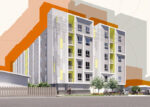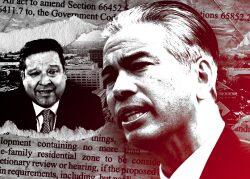The California state legislature has passed a slate of new pro-density housing bills less than eight months after SB 9 rezoned single-family real estate.
The four bills were passed late Monday and still need the signature of Gov. Gavin Newsom in order to become law. Newsom has until the end of September to make a decision on the legislation, and has not so far indicated his intentions.
Still, many of the bills’ supporters, who include progressive state politicians and pro-housing groups across the state such as California YIMBY, were already celebrating.
“It actually happened,” one Bay Area-based housing and transit advocate wrote on Twitter. “A truly incredible day for housing and climate policy in the world’s fifth largest economy!”
The advocate, Jordan Grimes, was referring to AB 2097, a bill that amounts to a statewide boost to residential and commercial development near public transit. Under the language of the bill, local public agencies are prohibited from imposing any minimum car parking requirements for projects located within a half mile of metro, bus or other transportation centers.
Another of the four bills, AB 2221, builds on the state’s recent efforts to incentivize ADU construction by clarifying rules around the so-called granny flats. Under existing law, developers are allowed to add the units only to existing multifamily buildings; the new bill extends that allowance to proposed projects. It also clarifies local agencies’ timelines for approving ADU, or accessory dwelling units, projects and raises certain height limits, among other changes.
The additional two bills, AB 2011 and SB 6, are companion bills that incentivize affordable housing construction in commercial areas and would likely be the slate’s most influential proposals. The legislation, called the “Affordable Housing and High Road Jobs Act of 2022,” would grant those projects “by right” approvals, exempting them from CEQA and local government approvals with certain stipulations. To qualify, 100 percent affordable projects must be located in areas currently primarily used for office, retail and parking, and mixed-income projects must be located in “commercial corridors” — local roads that are typically used for strip malls and parking lots.
The legislation is intended to “expand the potential sites where housing can be developed, while directing development away from existing residential neighborhoods — in particular, existing single-family neighborhoods,” according to a bill analysis.
It’s a proposal that seeks to take advantage of another real estate trend, the broad decline of large commercial shopping centers, and amounts to a reimagining of affordable housing development across the state. One analysis cited by proponents found the zoning change would open up the potential for 2 million new units just in Los Angeles County and Santa Clara County, which includes San Jose.
The legislation “has the potential to transform housing policy here in California,” Assemblymember Buffy Wicks, the author of AB 2011, said during a recent debate.
The two bills had been in jeopardy because of potential opposition from some of the state’s powerful labor unions, which sought to include labor workforce requirements. Last week, the Senate Pro Tem Toni Atkins and Assembly Speaker Anthony Rendon helped negotiate an agreement between the unions and housing advocates that helped cement the passage, the L.A. Times reported. In a statement, Rendon called the negotiation a “housing victory that checks off a lot of the boxes — affordability, mixed-use, transit accessibility and labor security.”
The new bills come at a moment when political leaders across the state are increasingly focused on housing production, but also as the impact of the most significant housing law California had seen in decades — SB 9, which eliminated most single-family zoning across the state and encourages ADUs — largely remains to be seen.
After a vigorous public debate, Newsom signed the bill into law last fall, and it came into effect in January. But nearly nine months later remarkably few projects under the law have been approved, and a host of cities, including Pasadena, have mounted high-profile battles related to implementation of the state law, raising questions about its future effectiveness.
In recent years legislators have proposed numerous, sometimes creative housing proposals aimed at tackling a housing deficit — and associated sky-high prices — that’s increasingly viewed as an urgent statewide emergency. One proposal, to incentivize housing construction on moribund golf courses, died in committee in May after an intense backlash from the golf industry.
Read more


